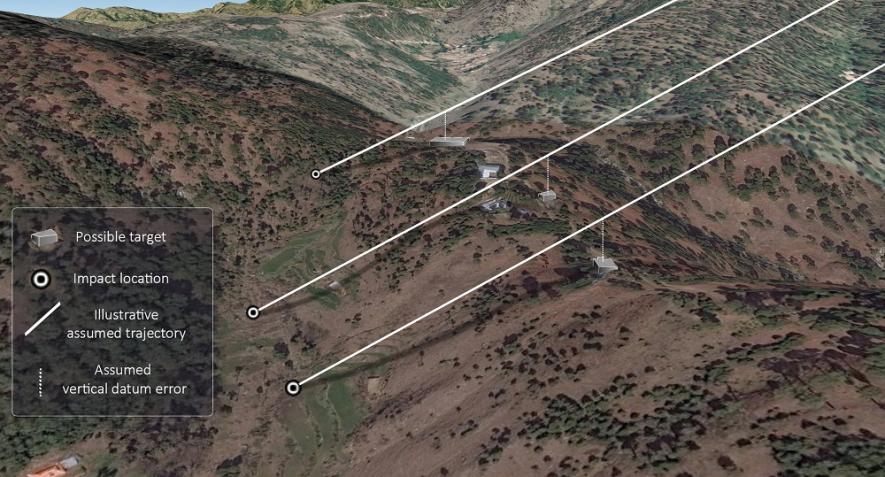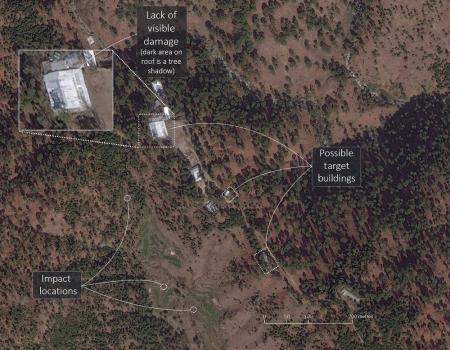Balakot Air Strike Missed Its Intended Targets, Suggests New Satellite Imagery

Satellite imagery © 2019 DigitalGlobe, a Maxar Technologies company—provided by European Space Imaging. Courtesy: The Strategist
Despite the Modi government claiming that the Indian air strike on Balakot killed “large number of terrorists”, newly available high-resolution satellite images show no visible damage to the buildings that were possibly targetted.
Taken a day after India’s bombing strike on a purported Jaish-e-Mohammad terrorist camp at Balakot in Pakistan on February 26, this publicly available imagery was acquired by European Space Imaging.
This new visual evidence of a lack of damage is odd — considering the Indian Air Force used ‘precision bombing’, or to be precise, the Israeli SPICE 2000 weapon to target four buildings at the terrorist camp, as reported by Indian media outlets.
An article published on March 27 on The Strategist, run by the Australian Strategic Policy Institute (ASPI), pointed out that the “conspicuously undamaged roofs” as seen in the imagery are “not consistent” with the weapon used.
Nonetheless, the three defence analysts writing the piece have sought to offer alternative explanations for this “very precise miss”.
“This imagery, imagery, which is of a higher resolution than that available previously, shows conspicuously undamaged roofs that are not consistent with either a SPICE 2000 strike or a strike with other munitions,” write the analysts.
Also read: IAF Air Strike: Will Pakistan Retaliate?
What is SPICE 2000?
The SPICE (Smart, Precise Impact, Cost-Effective) is an Israeli weapon, which is essentially a precision-guidance kit for bombs, and it can be guided either electro-optically or by GPS.
“The SPICE 2000 is the Israeli analogue of the US JDAM (joint direct attack munition), the weapon that has become the mainstay of coalition airstrikes in the Middle East,” says The Strategist.
“The SPICE 2000 is essentially a strap-on guidance kit that can transform a 2,000-pound ‘dumb’ bomb into a very precise way to deliver more than 400 kg of high explosives at a range of up to 60 kilometres.
…A 2,000-pound bomb causes substantial damage to structures.”
India claimed that the strike used a variant of SPICE 2000 loaded with reduced amounts of explosives “and the ability to penetrate through several floors of a building and even underground before detonating,” as the article notes.
“This argument claims that such a weapon would only create a small entry hole and, while it would kill all occupants, it wouldn’t destroy the target building.”
But the lack of visible damage or destruction tells another story.
As the analysts write: “We believe that even a weapon with reduced explosive fill would cause damage to buildings that would be identifiable in the satellite imagery.”

Technical Errors or A Deliberate, Precise Miss?
Analysing the images, the analysts found two factors that struck them.
First, all three weapons have missed the intended targets by similar (but not identical) distances, “and certainly by much more than the three metre ‘circular error probable’ attributed to the SPICE 2000,” point out the experts.
Second, all three weapons missed the targets in the same direction.
This suggests a “systematic targeting error” that caused the weapons to miss the targets, conclude the analysts.
The authors write it is “likely” that the Indian Air Force used GPS guidance for the weapon, specifically ‘set and forget’ capabilities.
They theorise that either incorrect information had been introduced into the GPS-guided weapon system or “data shifts” had been omitted.
The first explanation assumes that the SPICE 2000 bombs were “incorrectly programmed” to fly precisely into GPS points that were a certain distance above the intended targets.
The second explanation offered is that the error occurred because of a failure in converting “the coordinates from one coordinate system, or datum, to another”. This conversion process is called a ‘datum shift’.
The authors frame their questions and explanations as a generalised matter of possible reasons for the failure of precision bombing to hit the target — premised on the visually supported case of the Indian air strike missing its intended targets in Balakot.
In India, there was already controversy about whether the strike had actually hit its purported targets, the JeM terrorist camps, even as the Modi government boasted otherwise.
But even as this new satellite imagery lends further credence to the controversy, if we go by the new evidence, the question to ask is — Was this “systematic targeting error” a technical fault, or a deliberate move by the Modi government?
Also read: Will We Ever Know the Truth about the Balakot Air Strike?
Get the latest reports & analysis with people's perspective on Protests, movements & deep analytical videos, discussions of the current affairs in your Telegram app. Subscribe to NewsClick's Telegram channel & get Real-Time updates on stories, as they get published on our website.
























